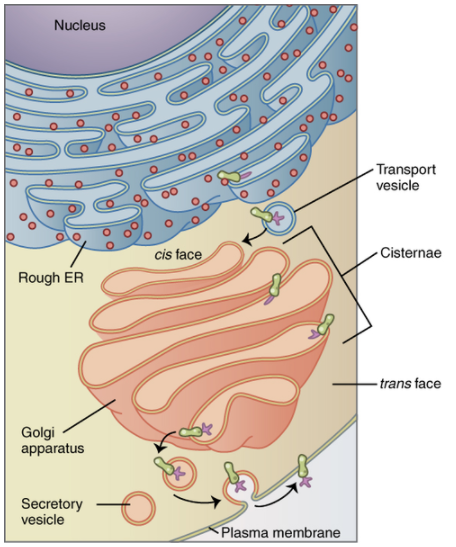
How many golgi bodies are in a cell?
Answer
465.3k+ views
Hint: Golgi apparatus(or complex, or body, or 'the 'Golgi') is found in all plant and creature cells and is the term given to gatherings of leveled circle like structures found near the endoplasmic reticulum. The compartments of the Golgi contraption look rather like a heap of Pitta breads with the one at the top and base not being smooth yet having torn open peripheral surfaces.
Complete answer:
The quantity of Golgi bodies inside a cell is variable. Animal cells will in general have less and bigger Golgi bodies. Plant cells can contain upwards of a few hundred more modest forms. The quantity of compartments in any one Golgi device is generally somewhere in the range of 3 and 8. For the most part inside a eukaryotic creature cell one Golgi body is available; however secretory cells may have multiple. In plant cells numerous Golgi apparatus could be available. The quantity of sets of Golgi mechanical assembly in a cell can be as not many as 1, as in numerous creature cells, or a huge number as in some plant cells. Particular secretory cells contain a greater number of sets of Golgi devices than do different cells.

The Golgi body is a segment of the cell that is composed of layers, and there are various sorts of layers. Some of them are tubules, and some of them are vesicles. The Golgi is found right close to the core. It's known as a perinuclear body, and it's in reality directly close to the endoplasmic reticulum too.
Note: The Golgi body is a significant assortment and dispatch station of protein items got from the endoplasmic reticulum (ER). Proteins integrated in the ER are bundled into vesicles, which at that point intertwine with the Golgi mechanical assembly. These freight proteins are changed and bound for discharge through exocytosis or for use in the cell. In this regard, the Golgi can be thought of as like a mail center: it bundles and marks things which it at that point ships off various pieces of the cell or to the extracellular space. The Golgi contraption is additionally associated with lipid transport and lysosome arrangement.
Complete answer:
The quantity of Golgi bodies inside a cell is variable. Animal cells will in general have less and bigger Golgi bodies. Plant cells can contain upwards of a few hundred more modest forms. The quantity of compartments in any one Golgi device is generally somewhere in the range of 3 and 8. For the most part inside a eukaryotic creature cell one Golgi body is available; however secretory cells may have multiple. In plant cells numerous Golgi apparatus could be available. The quantity of sets of Golgi mechanical assembly in a cell can be as not many as 1, as in numerous creature cells, or a huge number as in some plant cells. Particular secretory cells contain a greater number of sets of Golgi devices than do different cells.

The Golgi body is a segment of the cell that is composed of layers, and there are various sorts of layers. Some of them are tubules, and some of them are vesicles. The Golgi is found right close to the core. It's known as a perinuclear body, and it's in reality directly close to the endoplasmic reticulum too.
Note: The Golgi body is a significant assortment and dispatch station of protein items got from the endoplasmic reticulum (ER). Proteins integrated in the ER are bundled into vesicles, which at that point intertwine with the Golgi mechanical assembly. These freight proteins are changed and bound for discharge through exocytosis or for use in the cell. In this regard, the Golgi can be thought of as like a mail center: it bundles and marks things which it at that point ships off various pieces of the cell or to the extracellular space. The Golgi contraption is additionally associated with lipid transport and lysosome arrangement.
Recently Updated Pages
Express the following as a fraction and simplify a class 7 maths CBSE

The length and width of a rectangle are in ratio of class 7 maths CBSE

The ratio of the income to the expenditure of a family class 7 maths CBSE

How do you write 025 million in scientific notatio class 7 maths CBSE

How do you convert 295 meters per second to kilometers class 7 maths CBSE

Write the following in Roman numerals 25819 class 7 maths CBSE

Trending doubts
State and prove Bernoullis theorem class 11 physics CBSE

What are Quantum numbers Explain the quantum number class 11 chemistry CBSE

Write the differences between monocot plants and dicot class 11 biology CBSE

1 ton equals to A 100 kg B 1000 kg C 10 kg D 10000 class 11 physics CBSE

State the laws of reflection of light

In northern hemisphere 21st March is called as A Vernal class 11 social science CBSE




